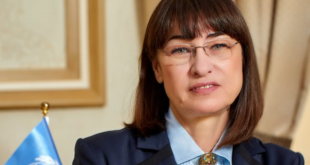Russia has upended the old rules-based order, Paul Mason writes. Europe needs to shape a new one.
Paul Mason*
While Western capitals scramble to send supplies of arms, munitions and aid to Ukraine, the strategic choices looming over the North Atlantic Treaty Organization are becoming clearer. NATO’s ‘strategic concept’—a 12-year-old guidance document—is due to be upgraded at a summit in Madrid in June. Yet few of the foreign ministers meeting at the alliance headquarters in Brussels last week wanted to be frank about the choices they face.
Much, of course, depends on the final outcome of the war. Realistic scenarios range from operational defeat of the Russian forces, leading to a frozen conflict in the Donbas and the armed neutrality of Ukraine, to partition—with in the Russian-controlled zone a regime of ‘de-Ukrainisation’, massacres and forced population movements, as the West looks on helplessly.
The variables include what happens to Western public opinion. Will Sweden and Finland join NATO? Will, more immediately, Emmanuel Macron defeat the Putin-sympathetic Marine Le Pen in the French presidential election? And will the United States presidency remain in the hands of politicians committed to the NATO project?
All these questions are in doubt. But if the answer is ‘yes’ in each case there is an opportunity to make big changes in military spending, posture, force structure and technology—with a clear pathway outlined before Madrid.
No more rules
First, NATO’s leaders need to recognise what is new. In their joint statement of February 4th, the Chinese and Russian presidents, Xi Jinping and Vladimir Putin respectively, declared the rules-based international order over. They were not presenting a document for discussion—they were stating what for them was a fact.
NATO, along with the United Nations and the European Union, may choose to go on affirming that its goal is to maintain a rules-based order, but reality is no longer rules-based. Though there is much to despise in the ‘realist’ school of international relations—with its pre-globalisation assumptions of taken-for-granted ‘national interests’—we are at a moment where realism, in the sense of cool objectivity, is at a premium.
The international system is not just broken but fractured in a manner unlike ever before. The great-power system which collapsed in 1914 was a complex balancing act among at least six states: Britain, the US, France, Germany, Austria-Hungary, Russia and Japan. Even the great duel of the mid-20th century, between the ‘axis’ and the ‘allies’, was a mosaic of different wars and rivalries. In both cases, war was a result of an interregnum in which a declining power was losing grip but its rising replacement could not exert control.
Today, China and Russia have announced the start of a systemic conflict among three rival ‘maternities’: Western democracy, Chinese totalitarianism and Russian totalitarianism; the latter two in a strategic alliance. It implies the division of the world into semi-permanent blocs.
Russia’s overt target is the breakup of NATO, the EU and any other structure in the international architecture which gets in its way. Thus, in Madrid, there can be no room for the fiction that ‘NATO is nobody’s adversary’. Russia has declared NATO its adversary. Western politicians and electorates need to understand this fate, even though it is not one they chose.
‘Strategic autonomy’
So, the second big piece of reframing has to involve European ‘strategic autonomy’. Long pursued by Macron, this has been given impetus by the Zeitenwende (historical turn) declared by the German chancellor, Olaf Scholz.
Before Putin attacked Ukraine, one could argue that the EU needed strategic autonomy because the US was no longer a reliable ally, European capitalism needed to exert some sovereignty over technology and information, and the European powers needed to ‘take the strain’ from America in deterring Russian aggression. Europe would then find its own centre of gravity, in security terms, with Russia.
Strategic autonomy remains worthy of support but the Russian invasion—and the two draft treaties, with NATO and the US, which Putin slapped on the table in December—change things. It is vital, for the next ten years at least, to keep the US actively engaged in the defence of NATO’s Eastern flank. That means NATO, not the EU, playing the leading role in Europe’s security. Idealism might make us wish this were otherwise; realism demands recognising the facts.
NATO expansion
The third question concerns NATO expansion. Sweden and Finland should, and likely will, join NATO. It will be an uneven bargain, since Finland—with its 280,000-strong reserve-based armed forces—will field a force bigger than the entire armies of Sweden and the Baltic states put together. In return it will open its thousand-kilometre frontier to militarisation.
But with the addition of two welfare economies, currently under social-democratic leadership, and the renewed activism of the German social-democrat-led government, the political centre of gravity of NATO in Europe will change. We will have Norway, Portugal, Spain, Germany, Finland and Sweden led by the centre-left and even centre/radical-left coalitions.
If these governments, and indeed the Party of European Socialists, the Greens and the European Left political parties, were to outline a united strategic concept for NATO, it could have a powerful influence on the debate heading towards Madrid. The most convincing argument deployed by the NATO secretary general (and former Norwegian social-democrat premier), Jens Stoltenberg, as Russia’s proxies accused NATO of encirclement before February 24th when the invasion began, was that NATO remained a primarily defensive alliance.
The new strategic concept should formalise this, abandoning the goal of ‘crisis management’ beyond NATO’s area and its immediate periphery. This goal evolved as the result of the neoconservative ‘out of area or out of business’ philosophy, developed at the height of American hubris—it should be ditched for good. If NATO’s major powers were to give Ukraine clear and binding security guarantees, they could then recognise de jure what is already de facto: neither Ukraine nor Georgia will be joining NATO this side of the fall of the Putin regime.
Soft power
That leads to the fourth major decision—on projection of ‘soft power’ into Russia and the negation of Putin’s hybrid-warfare offensive against Western democracies. While ‘regime change’ cannot be NATO’s goal, it should be the stated aim of Europe’s progressive political parties to help reinstate democracy and the rule of law in Russia, by supporting those forces which uphold them.
In addition, NATO’s new concept should encourage each member state to set up taskforces to counter hybrid attacks. This is tricky, because it involves letting police, security and intelligence services and financial regulators operate proactively inside one’s own society against an adversary which uses its democracy, free speech and ‘free markets’ as cover. Elaborating a new, rule-of-law-based practice in this arena is a challenge the left and progressive parties should actively embrace—not leave to the ‘securocrats’ and the right.
Whatever the details of the new force structure required, the broad picture is clear: as in Jaws, we’re going to need a bigger boat. If Russia has strategically dissolved its far-East military district, moving the entire force into the Western theatre, then to deter Russia from attacking its NATO neighbours entails a forward-deployed armed force with enough combat power to destroy the aggressor in short order.
In Britain, for example, the hubristic Tory strategy of ‘global reach’—allied to Brexit folie de grandeur but undermined by austerity—has seen the army actually shrink by 10,000 trained soldiers, redesigned around light-infantry intervention forces such as have been deployed in Mali. The result is that, even to field a single armoured warfighting division—the basic building-block of a NATO conventional deterrent—would take the UK until 2030. If, in reality, two permanent UK divisions are going to be needed in mainland Europe—as during the cold war—British decision-makers are going to have to grasp that nettle quickly.
Convincing deterrent
But expanding the armed forces won’t be easy. Many European military powers are deep in debt. Others, such as Germany and indeed the EU – as a whole -remain formally committed to rules demanding fiscal restraint. To mount a convincing deterrent without bankrupting the states funding it will need three things NATO countries have not so far done convincingly.
The first is the creation of large reserve armies, parallel to the professional army, deeply rooted in the multi-ethnic and socially-liberal societies they are defending and with corresponding social legitimacy. Reserve armies are never popular with professional soldiers—because they compete for resources and undermine their élan—but in the two major global conflicts of the 20th century they proved decisive. Ukraine’s territorial-defence brigades are making that point once more.
The second is interoperability and transnational procurement. We don’t know what a major renewal of defence technologies co-ordinated in a neoliberal economic system would look like—because the cold-war arms race was largely carried out with Keynesian methods. My guess is that, without clear, directed industrial planning (not the gestural ‘industrial strategies’ practised today), it would be a fiasco.
In the neoliberal era, the defence ministries of Europe and the US became past masters at procuring equipment, which was late, over budget and barely worked. Whereas in the second world war military technologies advanced faster than civilian, in the digital era the roles have reversed. The private sector innovates in two-year cycles; the defence industry, at best, in cycles of seven to 15 years. The latter needs to find ways to conform with the former.
Thirdly, we need to open up a decisive technological gap in defence between the West and Russia. With the F-35 fighter jet, for example, giving its users a generational edge over potential Russian adversaries, the contest should be accelerated to achieve the sixth generation of combat aircraft. With the race on over truly hypersonic missiles, missile-defence systems and combat in space, Europe needs to exploit its scale and specialisms to get in and start winning.
NATO announced a Defence Innovation Accelerator for the North Atlantic (DIANA) last week, but it remains a network of existing facilities. To redirect talent and resources into defence innovation will need a lot more state direction. Outpacing Russia in the critical defence technologies has to be a mobilising principle for all governments, not just somewhere on a wish list.
Tough choices
If NATO were to adopt such a strategy in Madrid, within five years it might have new, forward-deployed divisions from Northern Finland to the Black Sea; large reserve forces capable of deployment in central Europe in times of crisis; overwhelming superiority in air combat, drones and missile defence; navies capable of deterring Russian aggression, and space platforms capable of surviving any Russian destructive actions.
Achieving this will require tough choices—about borrowing, taxing and spending. About shaking up cosy relationships with defence contractors. And about priorities: if the priority is to defend Europe, it cannot also be to project offensive power into the South China Sea.
That’s why the ‘global Britain’ conceit of the UK prime minister, Boris Johnson, has been so disastrous. Europe, for its own strategic reasons, needs to stabilise its relationships with China, while actively deterring and destabilising Putin’s Russia.
More important than all of this is to carry NATO-member electorates on the journey. Few among them really understand the catastrophic nature of Putin’s gambit. Many are watching the war in Ukraine almost as if it were snapshots from a computer game, happy to send warm wishes to the victims—little suspecting that, if things go really badly, those scenes could occur in their own cities within the decade.
The price of NATO membership, for Europe’s welfare democracies, is high and it is about to rise. In return, they should begin to articulate their own distinct agenda. Alien as that may appear to the traditional, neoconservative, Anglo-American securocrats, it could be the path to survival.
This is a joint publication bySocial Europe and IPS-Journal
*The writer is a journalist, writer and filmmaker. His forthcoming book ‘How To Stop Fascism: History, Ideology, Resistance’ will be published by Allen Lane. His most recent films include ‘R is For Rosa’, with Rosa Luxembourg Stiftung. He writes weekly for New Statesman and contributes to Der Freitag and Le Monde Diplomatique.
From: Social Europe.






